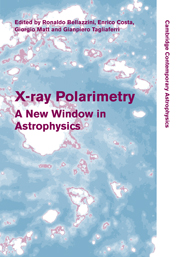Book contents
- Frontmatter
- Contents
- List of contributors
- Preface
- 1 X-ray polarimetry: historical remarks and other considerations
- Part I Polarimetry techniques
- Part II Polarized emission in X-ray sources
- 14 Probing strong gravity effects with X-ray polarimetry
- 15 X-ray polarization from black holes in the thermal state
- 16 Strong-gravity effects acting on polarization from orbiting spots
- 17 Polarization of thermal emission from accreting black holes
- 18 X-ray polarimetry and radio-quiet AGN
- 19 The soft X-ray polarization in obscured AGN
- 20 The polarization of complex X-ray sources
- 21 Polarization of Compton X-rays from jets in AGN
- 22 Polarization of X-ray lines from galaxy clusters and elliptical galaxies
- 23 Polarization characteristics of rotation-powered pulsars
- 24 Polarized X-rays from magnetized neutron stars
- 25 Polarization properties of X-ray millisecond pulsars
- 26 X-ray polarization signatures of neutron stars
- 27 Polarization from the oscillating magnetized accretion torus
- 28 X-ray polarization from accreting white dwarfs and associated systems
- 29 Polarization of pulsar wind nebulae
- 30 X-ray polarization of gamma-ray bursts
- 31 Central engine afterglow from GRBs and the polarization signature
- 32 GRB afterglow polarimetry past, present and future
- 33 Gamma-ray polarimetry with SPI
- 34 INTEGRAL/IBIS observations of the Crab nebula and GRB 041219A polarization
- 35 Fermi results on the origin of high-energy emission in pulsars
- 36 Diagnostics of the evolution of spiral galaxies in a cluster environment
- Part III Future missions
- Author index
- Subject index
25 - Polarization properties of X-ray millisecond pulsars
from Part II - Polarized emission in X-ray sources
Published online by Cambridge University Press: 06 July 2010
- Frontmatter
- Contents
- List of contributors
- Preface
- 1 X-ray polarimetry: historical remarks and other considerations
- Part I Polarimetry techniques
- Part II Polarized emission in X-ray sources
- 14 Probing strong gravity effects with X-ray polarimetry
- 15 X-ray polarization from black holes in the thermal state
- 16 Strong-gravity effects acting on polarization from orbiting spots
- 17 Polarization of thermal emission from accreting black holes
- 18 X-ray polarimetry and radio-quiet AGN
- 19 The soft X-ray polarization in obscured AGN
- 20 The polarization of complex X-ray sources
- 21 Polarization of Compton X-rays from jets in AGN
- 22 Polarization of X-ray lines from galaxy clusters and elliptical galaxies
- 23 Polarization characteristics of rotation-powered pulsars
- 24 Polarized X-rays from magnetized neutron stars
- 25 Polarization properties of X-ray millisecond pulsars
- 26 X-ray polarization signatures of neutron stars
- 27 Polarization from the oscillating magnetized accretion torus
- 28 X-ray polarization from accreting white dwarfs and associated systems
- 29 Polarization of pulsar wind nebulae
- 30 X-ray polarization of gamma-ray bursts
- 31 Central engine afterglow from GRBs and the polarization signature
- 32 GRB afterglow polarimetry past, present and future
- 33 Gamma-ray polarimetry with SPI
- 34 INTEGRAL/IBIS observations of the Crab nebula and GRB 041219A polarization
- 35 Fermi results on the origin of high-energy emission in pulsars
- 36 Diagnostics of the evolution of spiral galaxies in a cluster environment
- Part III Future missions
- Author index
- Subject index
Summary
Radiation of X-ray bursts and of accretion shocks in weakly magnetized neutron stars in low-mass X-ray binaries is produced in plane-parallel atmospheres dominated by electron scattering. We first discuss polarization produced by single (non-magnetic) Compton scattering, in particular the depolarizing effect of high electron temperature, and then the polarization due to multiple electron scattering in a slab. We further predict the X-ray pulse profiles and polarization properties of nuclear-and accretion-powered millisecond pulsars. We introduce a relativistic rotation vector model, which includes the effect of rotation of polarization plane due to the rapid motion of the hot spot as well as the light bending. Future observations of the X-ray polarization will provide a valuable tool to test the geometry of the emission region in pulsars and its physical characteristics.
Introduction
Polarization has proved to be a valuable tool in determining the geometry of the emission region in radio pulsars. For X-ray pulsars, the data are not yet available, but their interpretation in any case is not going to be easy, because of the strong magnetic field effects on the radiation transport. Discovery of millisecond coherent pulsations during X-ray bursts in nearly 20 low-mass X-ray binaries (so-called nuclear-powered millisecond pulsars (NMSP) see and in the persistent emission of at least eight sources (accretion-powered millisecond pulsars (AMSP) see opens a completely new range of possibilities. The emission in these cases is produced at the surface of a rapidly spinning, weakly magnetized neutron star.
- Type
- Chapter
- Information
- X-ray PolarimetryA New Window in Astrophysics, pp. 168 - 175Publisher: Cambridge University PressPrint publication year: 2010



